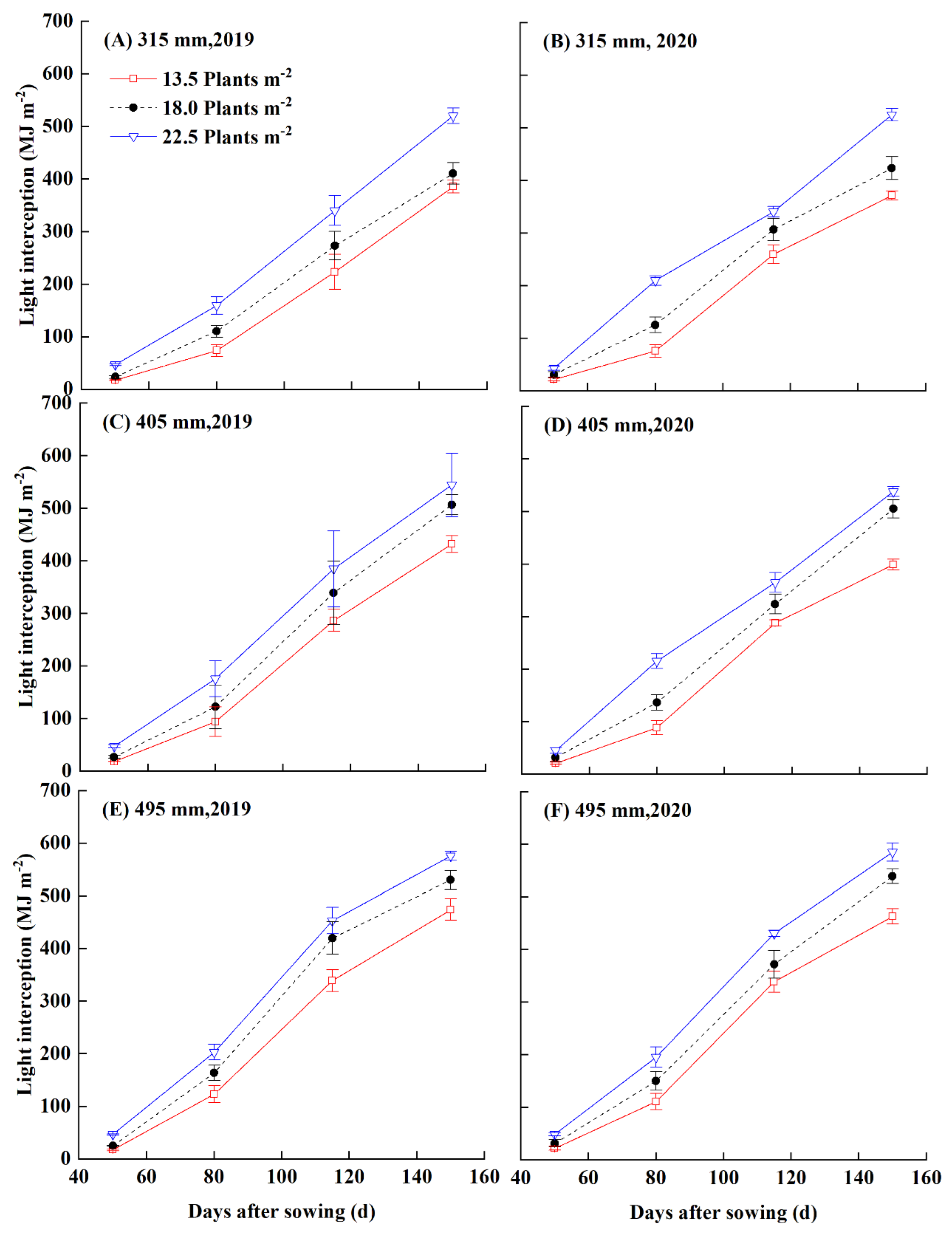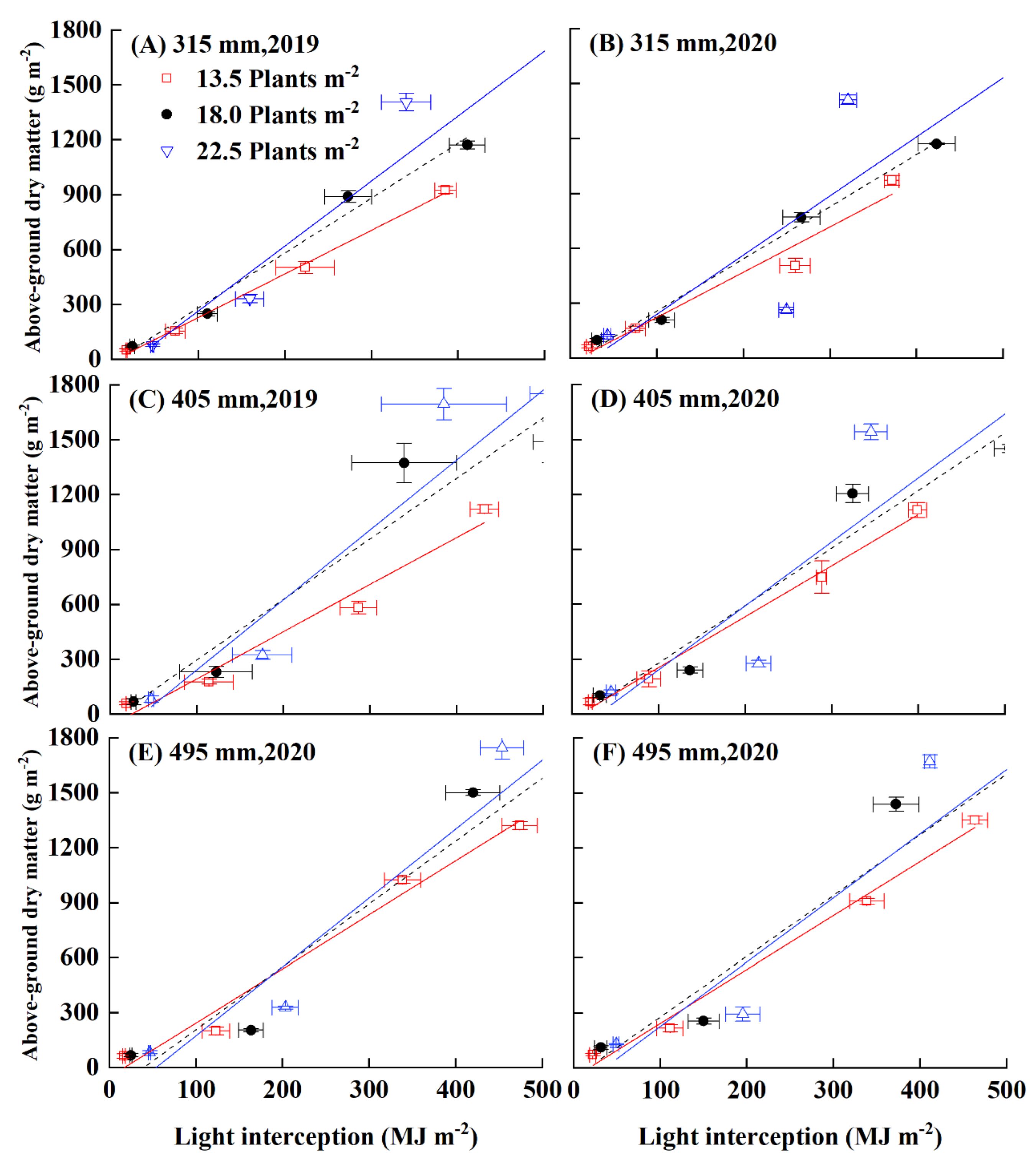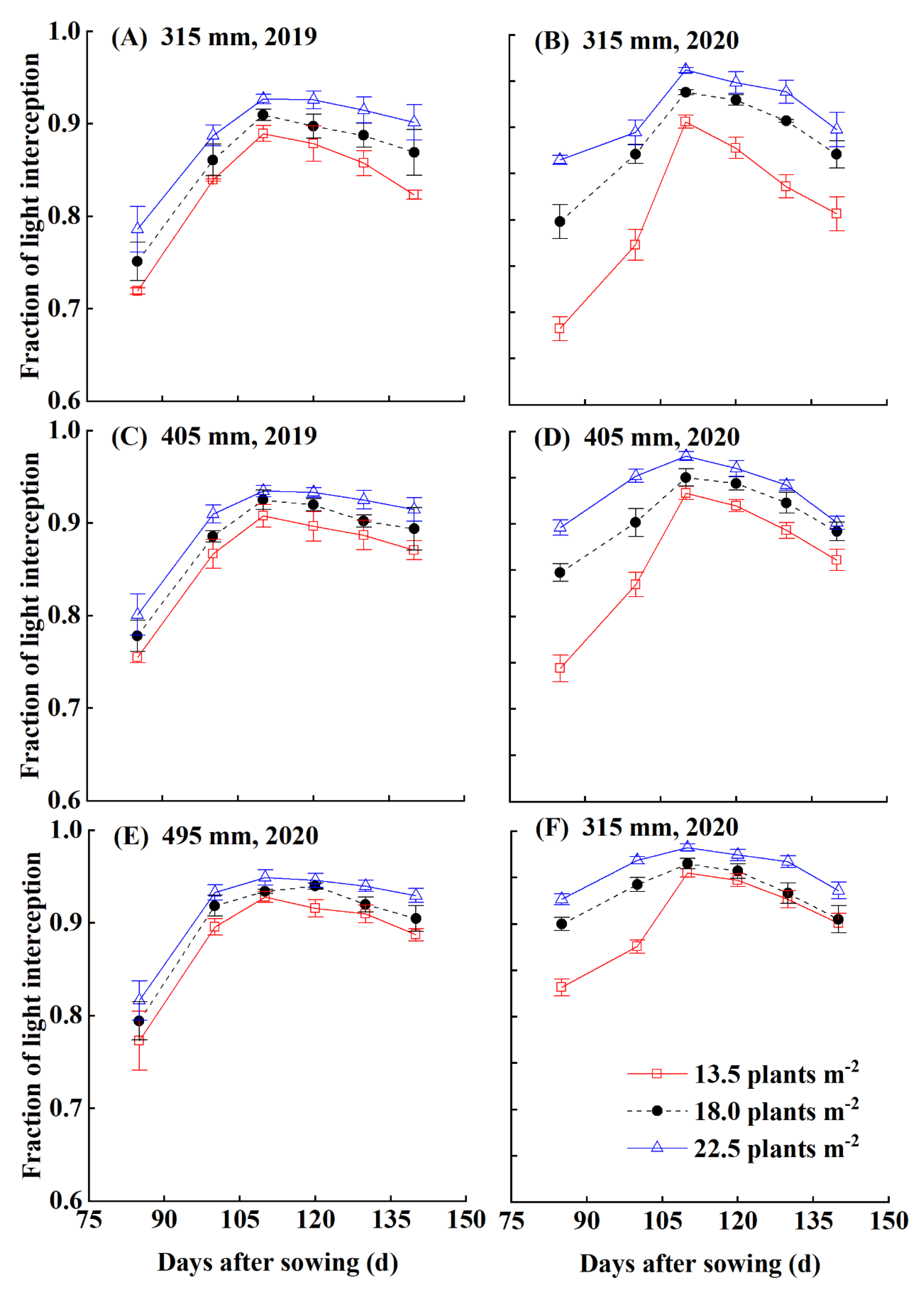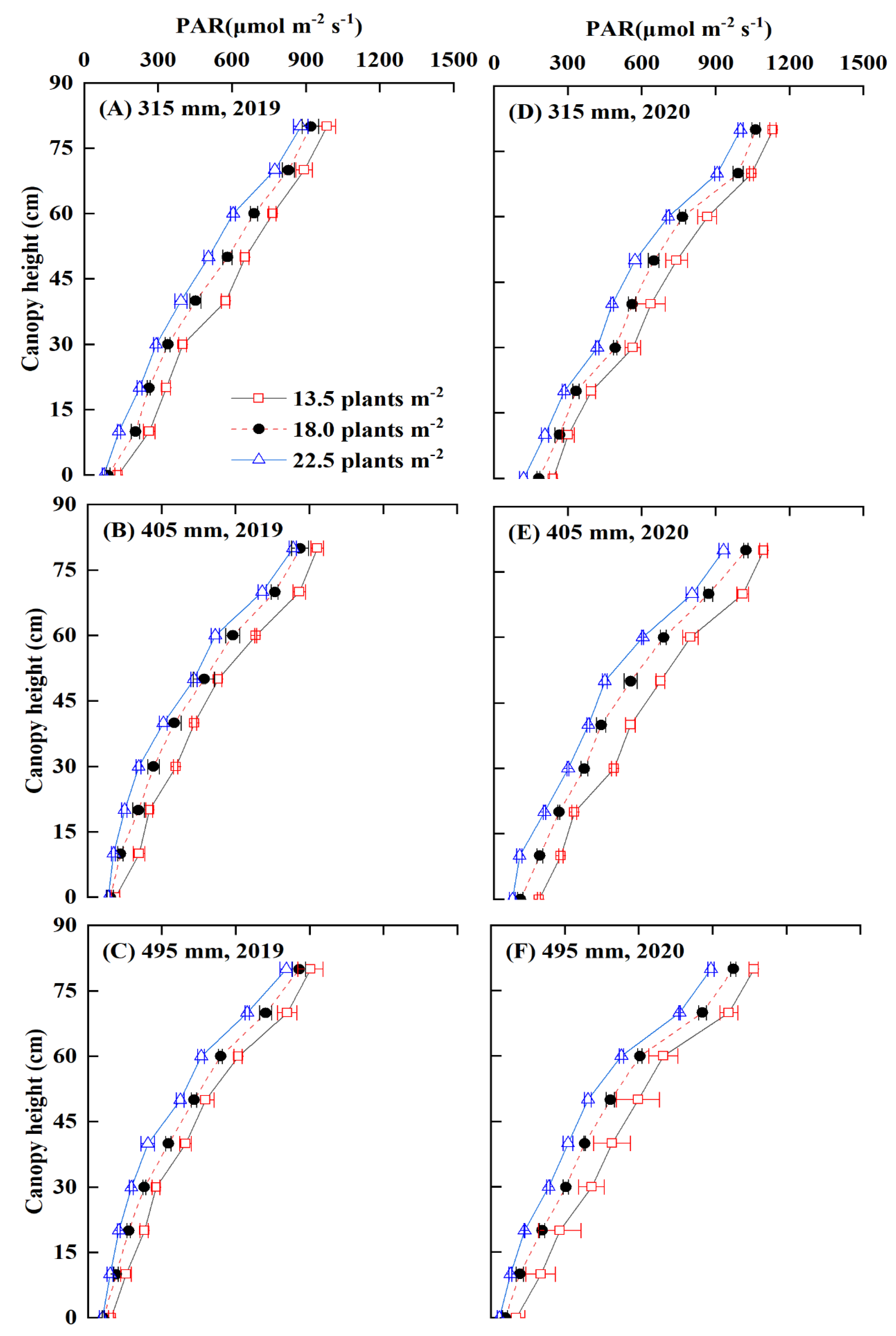Reducing Irrigation and Increasing Plant Density Enhance Both Light Interception and Light Use Efficiency in Cotton under Film Drip Irrigation
Abstract
:1. Introduction
2. Materials and Methods
2.1. Experimental Site
2.2. Experimental Design and Field Management
2.3. Measurements
2.3.1. Above-Ground Dry Matter
2.3.2. Leaf Area Index
2.3.3. Photosynthetic Effective Radiation, Light Interception and Light Use Efficiency
2.3.4. Light Extinction Coefficient
2.4. Statistical Analysis
3. Results
3.1. Above-Ground Dry Matter, Light Interception and Light Use Efficiency
3.2. Leaf Area Index
3.3. The Fractional of Light Interception
3.4. Light Extinction Coefficient
3.5. Spatial Distribution of Light
4. Discussion
4.1. Effects of Irrigation Quota and Planting Density on Above-Ground Dry Matter
4.2. Effects of Irrigation Quota and Planting Density on Leaf Area Index and Light Interception
4.3. Effects of Irrigation Quota and Planting Density on Light Use Efficiency
5. Conclusions
Author Contributions
Funding
Data Availability Statement
Conflicts of Interest
References
- Wen, Y.; Wu, X.; Liu, J.; Zhang, J.; Song, L.; Zhu, Y.; Li, W.; Wang, Z. Effects of drip irrigation timing and water temperature on soil conditions, cotton phenological period, and fiber quality under plastic film mulching. Agric. Water Manag. 2023, 287, 108435. [Google Scholar] [CrossRef]
- Shen, Y.J.; Li, S.; Chen, Y.N.; Qi, Y.Q.; Zhang, S.W. Estimation of regional irrigation water requirement and water supply risk in the arid region of Northwestern China 1989–2010. Agric. Water Manag. 2013, 128, 55–64. [Google Scholar] [CrossRef]
- Ali, S.; Xu, Y.; Ahmad, I.; Jia, Q.; Ma, X.; Sohail, A.; Manzoor; Arif, M.; Ren, X.; Cai, T.; et al. The ridge-furrow system combined with supplemental irrigation strategies to improves radiation use efficiency and winter wheat productivity in semi-arid regions of China. Agric. Water Manag. 2019, 213, 76–86. [Google Scholar] [CrossRef]
- Yazar, A.; Sezen, S.M.; Sesveren, S. LEPA and trickle irrigation of cotton in the Southeast Anatolia Project (GAP) area in Turkey. Agric. Water Manag. 2002, 54, 189–203. [Google Scholar] [CrossRef]
- Kang, S.Z.; Zhang, J.H. Controlled alternate partial root-zone irrigation: Its physiological consequences and impact on water use efficiency. J. Exp. Bot. 2004, 55, 2437–2446. [Google Scholar] [CrossRef]
- Yang, C.; Luo, Y.; Sun, L.; Wu, N. Effect of Deficit Irrigation on the Growth, Water Use Characteristics and Yield of Cotton in Arid Northwest China. Pedosphere 2015, 25, 910–924. [Google Scholar] [CrossRef]
- Galdi, L.V.; Felipe, D.; Silva, B.; Jesus, R.; Echer, F.R. Interactive effects of increased plant density, cultivars and N rates in environments with different cotton yield recovery potential. Ind. Crop. Prod. 2022, 176, 114394. [Google Scholar] [CrossRef]
- Yao, H.; Zhang, Y.; Yi, X.; Zhang, X.; Zhang, W. Cotton responds to different plant population densities by adjusting specific leaf area to optimize canopy photosynthetic use efficiency of light and nitrogen. Field Crop. Res. 2016, 188, 10–16. [Google Scholar] [CrossRef]
- Adams, C.; Thapa, S.; Kimura, E. Determination of a plant population density threshold for optimizing cotton lint yield: A synthesis. Field Crop. Res. 2019, 230, 11–16. [Google Scholar] [CrossRef]
- Du, X.B.; Wang, Z.; Lei, W.; Kong, L.C. Increased planting density combined with reduced nitrogen rate to achieve high yield in maize. Sci. Rep. 2021, 11, 358. [Google Scholar] [CrossRef]
- Xue, H.Y.; Han, Y.C.; Li, Y.B.; Wang, G.P.; Feng, L.; Fan, Z.Y.; Du, W.L.; Yang, B.F.; Cao, C.G.; Mao, S.C. Spatial distribution of light interception by different plant population densities and its relationship with yield. Field Crop. Res. 2015, 184, 17–27. [Google Scholar] [CrossRef]
- Torres, G.M.; Koller, A.; Taylor, R.; Raun, W.R. Seed-oriented planting improves light interception, radiation use efficiency and grain yield of maize (Zea mays L.). Exp. Agric. 2016, 53, 210–225. [Google Scholar] [CrossRef]
- Hou, H.P.; Ma, W.; Noor, M.A.; Tang, L.P.; Li, C.F.; Ding, Z.S.; Zhao, M. Quantitative design of yield components to simulate yield formation for maize in China. J. Inter. Agric. 2020, 19, 668–679. [Google Scholar] [CrossRef]
- Zhang, Z.; Zhou, X.B.; Chen, Y.H. Effects of Irrigation and Precision Planting Patterns on Photosynthetic Product of Wheat. Agron. J. 2016, 108, 2322–2328. [Google Scholar] [CrossRef]
- Zhao, J.; Yang, X.G.; Lin, X.M.; Sassenrath, G.F.; Dai, S.W.; Lv, S.; Chen, X.C.; Chen, F.j.; Mi, G.h. Radiation Interception and Use Efficiency Contributes to Higher Yields of Newer Maize Hybrids in Northeast China. Agron. J. 2015, 107, 1473–1480. [Google Scholar] [CrossRef]
- AgronomyFront Plant SciLong, S.P.; Zhu, X.G.; Naidu, S.L.; Ort, D.R. Can improvement in photosynthesis increase crop yields? Plant Cell Environ. 2006, 29, 315–330. [Google Scholar] [CrossRef]
- Zhou, Z.J.; Plauborg, F.; Kristensen, K.; Andersen, M.N. Dry matter production, radiation interception and radiation use efficiency of potato in response to temperature and nitrogen application regimes. Agric. For. Mmeteorol. 2017, 232, 595–605. [Google Scholar] [CrossRef]
- Kuai, J.; Sun, Y.Y.; Zhou, M.; Zhang, P.P.; Zuo, Q.S.; Wu, J.S.; Zhou, G.S. The effect of nitrogen application and planting density on the radiation use efficiency and the stem lignin metabolism in rapeseed (Brassica napus L.). Field Crop. Res. 2016, 199, 89–98. [Google Scholar] [CrossRef]
- Zhang, D.S.; Sun, Z.X.; Feng, L.S.; Bai, W.; Yang, N.; Zhang, Z.; Du, G.J.; Feng, C.; Cai, Q.; Wang, Q.; et al. Maize plant density affects yield, growth and source-sink relationship of crops in maize/peanut intercropping. Field Crop. Res. 2020, 257, 107926. [Google Scholar] [CrossRef]
- Mao, L.L.; Zhang, L.Z.; Sun, X.Z.; van der Werf, W.; Evers, J.B.; Zhao, X.H.; Zhang, S.P.; Song, X.L.; Li, Z.H. Use of the beta growth function to quantitatively characterize the effects of plant density and a growth regulator on growth and biomass partitioning in cotton. Field Crop. Res. 2018, 224, 28–36. [Google Scholar] [CrossRef]
- Yao, H.S.; Zhang, Y.L.; Yi, X.P.; Zuo, W.Q.; Lei, Z.Y.; Sui, L.L.; Zhang, W.F. Characters in light-response curves of canopy photosynthetic use efficiency of light and N in responses to plant density in field-grown cotton. Field Crop. Res. 2017, 203, 192–200. [Google Scholar] [CrossRef]
- Hamzei, J.; Soltani, J. Deficit irrigation of rapeseed for water-saving: Effects on biomass accumulation, light interception and radiation use efficiency under different N rates. Agric. Ecosyst. Environ. 2012, 155, 153–160. [Google Scholar] [CrossRef]
- Yan, S.C.; Wu, Y.; Fan, J.L.; Zhang, F.C.; Guo, J.J.; Zheng, J.; Wu, L.F.; Lu, J.S. Quantifying nutrient stoichiometry and radiation use efficiency of two maize cultivars under various water and fertilizer management practices in northwest China. Agric. Water Manag. 2022, 271, 107772. [Google Scholar] [CrossRef]
- Zhang, D.S.; Zhang, L.Z.; Liu, J.G.; Han, S.; Wang, Q.; Evers, J.; Liu, J.; van der Werf, W.; Li, L. Plant density affects light interception and yield in cotton grown as companion crop in young jujube plantations. Field Crop. Res. 2014, 169, 132–139. [Google Scholar] [CrossRef]
- Wang, S.H.; Mao, L.L.; Shi, J.L.; Nie, J.J.; Song, X.L.; Sun, X.Z. Effects of plant density and nitrogen rate on cotton yield and nitrogen use in cotton stubble retaining fields. J. Inter. Agric. 2021, 20, 2090–2099. [Google Scholar] [CrossRef]
- Chen, H.X.; Zhao, X.X.; Han, Y.C.; Xing, F.F.; Feng, L.; Wang, Z.B.; Wang, G.P.; Yang, B.F.; Lei, Y.P.; Xiong, S.W.; et al. Competition for Light Interception in Cotton Populations of Different Densities. Agronomy 2021, 11, 176. [Google Scholar] [CrossRef]
- Li, X.F.; Han, Y.C.; Wang, G.P.; Feng, L.; Wang, Z.B.; Yang, B.F.; Du, W.L.; Lei, Y.P.; Xiong, S.W.; Zhi, X.Y.; et al. Response of cotton fruit growth, intraspecific competition and yield to plant density. Eur. J. Agron. 2020, 114, 125991. [Google Scholar] [CrossRef]
- Cheng, M.H.; Wang, H.D.; Fan, J.L.; Zhang, S.H.; Wang, Y.L.; Li, Y.P.; Sun, X.; Yang, L.; Zhang, F.C. Water productivity and seed cotton yield in response to deficit irrigation: A global meta-analysis. Agric. Water Manag. 2021, 255, 107027. [Google Scholar] [CrossRef]
- Zhang, D.; Luo, Z.; Liu, S.; Li, W.; Wei, T.; Dong, H. Effects of deficit irrigation and plant density on the growth, yield and fiber quality of irrigated cotton. Field Crop. Res. 2016, 197, 1–9. [Google Scholar] [CrossRef]
- Stewart, D.W.; Costa, C.; Dwyer, L.M.; Smith, D.L.; Hamilton, R.I.; Ma, B.L. Canopy Structure, Light Interception, and Photosynthesis in Maize. Agron. J. 2003, 95, 1465–1474. [Google Scholar] [CrossRef]
- Mao, L.L.; Zhang, L.Z.; Zhao, X.H.; Liu, S.D.; van der Werf, W.; Zhang, S.P.; Spiertz, H.; Li, Z.H. Crop growth, light utilization and yield of relay intercropped cotton as affected by plant density and a plant growth regulator. Field Crop. Res. 2014, 155, 67–76. [Google Scholar] [CrossRef]
- Zhang, Y.H.; Xu, Z.G.; Li, J.; Rui, W. Optimum Planting Density Improves Resource Use Efficiency and Yield Stability of Rainfed Maize in Semiarid Climate. Front. Plant Sci. 2021, 12, 752606. [Google Scholar] [CrossRef] [PubMed]
- Shao, H.; Shi, D.; Shi, W.; Ban, X.; Chen, Y.; Ren, W.; Chen, F.; Mi, G. Genotypic difference in the plasticity of root system architecture of field-grown maize in response to plant density. Plant Soil 2019, 439, 201–217. [Google Scholar] [CrossRef]
- Malik, M.; Edwards, D.G.; Evenson, J.P. Effects of Flower Bud Removal and Nitrogen Supply on Growth and Development of Cotton (Gossypium hirsutum L.). Funct. Plant Biol. 1981, 8, 285–291. [Google Scholar] [CrossRef]







| Year | Irrigation | Density | Above-Ground Dry Matter | Light Interception | Light Use Efficiency |
|---|---|---|---|---|---|
| (mm) | (Plants m−2) | (g m−2) | (MJ m−2) | (g MJ−1) | |
| 2019 | 315 | 13.5 | 971.49 c | 371.51 b | 2.46 b |
| 18 | 1170.7 b | 423.21 ab | 2.81 ab | ||
| 22.5 | 1549.4 a | 524.61 a | 3.23 a | ||
| SE | 73.72 | 20.73 | 0.11005 | ||
| 405 | 13.5 | 1115.2 c | 398.91 b | 2.77 b | |
| 18 | 1450.5 b | 505.11 a | 3.12 ab | ||
| 22.5 | 1632.8 a | 538.01 a | 3.46 a | ||
| SE | 66.12 | 19.14 | 0.10771 | ||
| 495 | 13.5 | 1351.6 c | 463.51 b | 2.89 b | |
| 18 | 1605.5 b | 539.41 ab | 3.28 a | ||
| 22.5 | 1762.5 a | 585.11 a | 3.49 a | ||
| SE | 55.02 | 17.13 | 0.08537 | ||
| 2020 | 315 | 13.5 | 925.16 c | 385.36 b | 2.37 c |
| 18 | 1171.97 b | 410.65 b | 2.93 b | ||
| 22.5 | 1617.08 a | 520.44 a | 3.50 a | ||
| SE | 87.39 | 19.57 | 0.16 | ||
| 405 | 13.5 | 1121.97 c | 432.10 b | 2.54 b | |
| 18 | 1488.34 b | 507.13 a | 3.26 a | ||
| 22.5 | 1751.68 a | 544.63 a | 3.68 a | ||
| SE | 80.46 | 17.68 | 0.17 | ||
| 495 | 13.5 | 1321.97 c | 474.03 b | 2.90 b | |
| 18 | 1593.47 b | 530.44 a | 3.37 a | ||
| 22.5 | 1848.96 a | 576.00 a | 3.71 a | ||
| SE | 67.88 | 15.23 | 0.11 | ||
| p-value | |||||
| Year | 0.118 | 0.500 | 0.116 | ||
| Irrigation | 0.000 | 0.000 | 0.000 | ||
| Density | 0.000 | 0.000 | 0.000 | ||
| Irrigation × Density | 0.000 | 0.000 | 0.485 | ||
| Year × Irrigation × Density | 0.998 | 0.995 | 0.890 | ||
| Year | Irrigation | Density | Am | Cm | te | tm |
|---|---|---|---|---|---|---|
| (mm) | (plants m−2) | m2 m−2 d−1 | d | d | ||
| 2019 | 315 | 13.5 | 2.42 b | 0.037 a | 120.36 a | 81.22 a |
| 18 | 2.55 ab | 0.034 a | 122.98 a | 74.09 a | ||
| 22.5 | 2.86 a | 0.040 a | 120.18 a | 75.26 a | ||
| SE | 0.079 | 0.001 | 0.947 | 1.63 | ||
| 405 | 13.5 | 2.58 b | 0.037 a | 122.24 a | 79.94 a | |
| 18 | 2.71 ab | 0.038 a | 118.85 a | 74.67 a | ||
| 22.5 | 2.97 a | 0.042 a | 121.95 a | 79.23 a | ||
| SE | 0.072 | 0.001 | 0.789 | 1.13 | ||
| 495 | 13.5 | 2.79 b | 0.041 a | 121.81 a | 81.45 a | |
| 18 | 3.24 a | 0.045 a | 125.39 a | 79.43 a | ||
| 22.5 | 3.17 a | 0.043 a | 122.54 a | 74.62 a | ||
| SE | 0.079 | 0.001 | 1.16 | 1.63 | ||
| 2020 | 315 | 13.5 | 2.30 c | 0.034 c | 119.29 a | 76.54 a |
| 18 | 2.81 b | 0.040 b | 117.86 a | 72.94 a | ||
| 22.5 | 3.24 a | 0.046 a | 118.21 a | 74.21 a | ||
| SE | 0.127 | 0.002 | 0.729 | 1.639 | ||
| 405 | 13.5 | 2.71 b | 0.040 b | 119.99 a | 78.51 a | |
| 18 | 3.01 b | 0.043 b | 117.52 b | 71.72 a | ||
| 22.5 | 3.51 a | 0.053 a | 114.09 c | 71.47 a | ||
| SE | 0.136 | 0.002 | 0.805 | 1.599 | ||
| 495 | 13.5 | 3.10 b | 0.045 b | 120.59 a | 78.68 a | |
| 18 | 3.43 b | 0.050 ab | 115.39 b | 72.58 a | ||
| 22.5 | 4.09 a | 0.061 a | 115.69 b | 73.42 a | ||
| SE | 0.155 | 0.003 | 0.903 | 1.844 | ||
| p-value | ||||||
| Year | 0.000 | 0.000 | 0.000 | 0.007 | ||
| Irrigation | 0.000 | 0.000 | 0.374 | 0.772 | ||
| Density | 0.000 | 0.000 | 0.058 | 0.001 | ||
| Irrigation × Density | 0.540 | 0.706 | 0.472 | 0.822 | ||
| Year × Irrigation × Density | 0.015 | 0.126 | 0.037 | 0.452 | ||
Disclaimer/Publisher’s Note: The statements, opinions and data contained in all publications are solely those of the individual author(s) and contributor(s) and not of MDPI and/or the editor(s). MDPI and/or the editor(s) disclaim responsibility for any injury to people or property resulting from any ideas, methods, instructions or products referred to in the content. |
© 2023 by the authors. Licensee MDPI, Basel, Switzerland. This article is an open access article distributed under the terms and conditions of the Creative Commons Attribution (CC BY) license (https://creativecommons.org/licenses/by/4.0/).
Share and Cite
Wu, F.; Tang, Q.; Zhang, L.; Cui, J.; Tian, L.; Guo, R.; Wang, L.; Chen, B.; Zhang, N.; Ali, S.; et al. Reducing Irrigation and Increasing Plant Density Enhance Both Light Interception and Light Use Efficiency in Cotton under Film Drip Irrigation. Agronomy 2023, 13, 2248. https://doi.org/10.3390/agronomy13092248
Wu F, Tang Q, Zhang L, Cui J, Tian L, Guo R, Wang L, Chen B, Zhang N, Ali S, et al. Reducing Irrigation and Increasing Plant Density Enhance Both Light Interception and Light Use Efficiency in Cotton under Film Drip Irrigation. Agronomy. 2023; 13(9):2248. https://doi.org/10.3390/agronomy13092248
Chicago/Turabian StyleWu, Fengquan, Qiuxiang Tang, Lizhen Zhang, Jianping Cui, Liwen Tian, Rensong Guo, Liang Wang, Baiqing Chen, Na Zhang, Saif Ali, and et al. 2023. "Reducing Irrigation and Increasing Plant Density Enhance Both Light Interception and Light Use Efficiency in Cotton under Film Drip Irrigation" Agronomy 13, no. 9: 2248. https://doi.org/10.3390/agronomy13092248
APA StyleWu, F., Tang, Q., Zhang, L., Cui, J., Tian, L., Guo, R., Wang, L., Chen, B., Zhang, N., Ali, S., Lin, T., & Jiang, P. (2023). Reducing Irrigation and Increasing Plant Density Enhance Both Light Interception and Light Use Efficiency in Cotton under Film Drip Irrigation. Agronomy, 13(9), 2248. https://doi.org/10.3390/agronomy13092248





